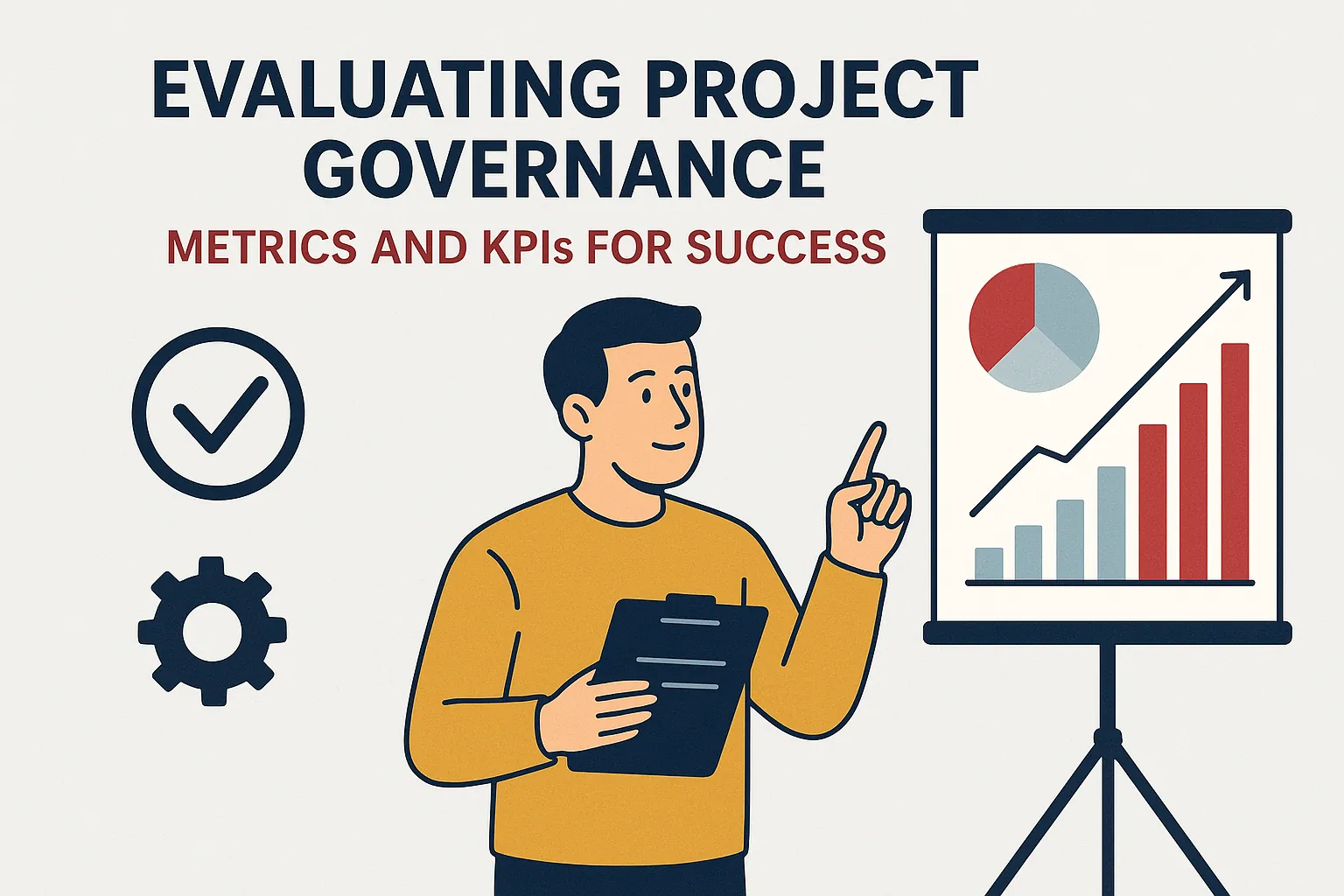Introduction to Project Governance
Project governance is a critical framework that guides project management practices, ensuring that projects are executed effectively and align with organizational objectives. It encompasses the structures, processes, and decision-making mechanisms that define how projects are managed and controlled. Understanding project governance is essential for project managers and organizational analysts, as it directly influences project outcomes and overall success.
Definition of Project Governance
Project governance refers to the set of policies, regulations, and procedures that dictate how a project is directed and controlled. It establishes the roles and responsibilities of stakeholders, defines the decision-making hierarchy, and outlines the processes for monitoring and reporting project progress. Effective project governance ensures that projects are aligned with strategic goals and that resources are utilized efficiently.
The Role of Governance in Project Success
The role of governance in project success cannot be overstated. It serves as a foundation for accountability and transparency, enabling stakeholders to understand their roles and the expectations placed upon them. Key aspects of governance that contribute to project success include:
- Decision-Making Authority: Clear governance structures empower project managers to make informed decisions swiftly, reducing delays and enhancing responsiveness to challenges.
- Risk Management: Governance frameworks facilitate the identification, assessment, and mitigation of risks, ensuring that potential issues are addressed proactively.
- Stakeholder Engagement: Effective governance promotes stakeholder involvement, fostering collaboration and communication among team members, sponsors, and other interested parties.
Overview of the Relationship Between Governance and Project Management
The relationship between governance and project management is symbiotic. While project management focuses on the execution of tasks and delivery of project outputs, governance provides the overarching framework that guides these activities. Key points of intersection include:
- Alignment with Organizational Strategy: Governance ensures that project objectives are aligned with the broader strategic goals of the organization, enhancing the relevance and impact of project outcomes.
- Performance Measurement: Governance frameworks often incorporate key performance indicators (KPIs) that allow for the assessment of project performance against established benchmarks, facilitating continuous improvement.
- Compliance and Standards: Governance establishes compliance with industry standards and regulatory requirements, ensuring that projects adhere to best practices and ethical guidelines.
Understanding Metrics and KPIs in Project Governance
Effective governance is crucial for ensuring that projects are delivered on time, within scope, and aligned with organizational objectives. A key component of evaluating project governance is the use of metrics and key performance indicators (KPIs). This section will define these terms, explain their importance in assessing governance, and highlight the differences between them.
Definition of Metrics and Key Performance Indicators (KPIs)
- Metrics are quantifiable measures used to track and assess the status of a specific process or activity. They provide data that can help project managers understand how well a project is performing against its goals. Examples of metrics in project management include budget variance, schedule variance, and resource utilization rates.
- Key Performance Indicators (KPIs), on the other hand, are a subset of metrics that are specifically tied to the strategic objectives of an organization. KPIs are designed to provide insight into the success of a project in achieving its goals. For instance, a KPI might measure customer satisfaction levels or the percentage of project milestones achieved on time. KPIs are often more focused and aligned with the overall vision of the organization, making them critical for governance assessments.
Importance of Metrics and KPIs in Assessing Governance
The use of metrics and KPIs in project governance is vital for several reasons:
- Performance Measurement: They provide a framework for measuring the performance of a project against predefined goals. This allows project managers to identify areas of success and those needing improvement.
- Informed Decision-Making: By analyzing metrics and KPIs, project managers can make data-driven decisions that enhance project outcomes. This is particularly important in governance, where decisions must align with organizational strategy.
- Accountability and Transparency: Metrics and KPIs foster accountability among project teams. When performance is measured and reported, it creates a culture of transparency, where team members are aware of their contributions to project success.
- Continuous Improvement: Regularly reviewing metrics and KPIs enables organizations to learn from past projects, leading to improved processes and governance structures in future initiatives.
Differences Between Metrics and KPIs
While metrics and KPIs are often used interchangeably, they serve different purposes in project governance:
- Scope: Metrics can encompass a wide range of data points related to project performance, while KPIs are specifically selected metrics that reflect critical success factors aligned with strategic objectives.
- Focus: Metrics may provide insights into operational efficiency, whereas KPIs are focused on outcomes that drive organizational success. For example, a metric might track the number of tasks completed, while a KPI would measure the impact of those tasks on overall project success.
- Actionability: KPIs are designed to be actionable, meaning they should prompt specific actions or decisions. Metrics, while informative, may not always lead to direct actions unless they are tied to strategic goals.
Key Performance Indicators for Project Governance
Effective governance is crucial for ensuring that projects are delivered on time, within budget, and to the desired quality standards. To evaluate the effectiveness of governance structures, project managers and organizational analysts can utilize specific Key Performance Indicators (KPIs). Below are key metrics that can be employed to assess governance effectiveness:
1. Stakeholder Engagement Metrics
- Stakeholder Satisfaction Score: This metric gauges the satisfaction levels of stakeholders involved in the project. Surveys can be conducted to assess their perceptions of the project’s progress and outcomes.
- Engagement Frequency: Tracking how often stakeholders are engaged through meetings, updates, and feedback sessions can provide insights into the level of involvement and commitment.
- Stakeholder Influence Assessment: Evaluating the impact of stakeholders on project decisions can help identify key players and their contributions to governance.
2. Decision-Making Efficiency Indicators
- Time to Decision: Measuring the average time taken to make key project decisions can highlight the efficiency of the governance process. Shorter decision times often indicate a more agile governance structure.
- Decision Quality Rating: Post-decision evaluations can assess the effectiveness of decisions made, considering factors such as alignment with project goals and stakeholder satisfaction.
- Approval Rate: The percentage of decisions that receive timely approval can indicate the responsiveness of the governance framework.
3. Risk Management KPIs
- Risk Identification Rate: This metric tracks the number of risks identified during the project lifecycle. A higher rate may suggest proactive governance practices.
- Risk Mitigation Effectiveness: Evaluating the success of implemented risk mitigation strategies can provide insights into the governance framework’s ability to manage uncertainties.
- Incident Frequency: Monitoring the number of incidents or issues that arise can help assess the effectiveness of risk management processes.
4. Compliance and Audit Metrics
- Compliance Rate: This KPI measures the percentage of project activities that adhere to established policies, regulations, and standards. High compliance rates indicate robust governance.
- Audit Findings: The number and severity of findings from internal or external audits can provide insights into governance effectiveness. Fewer findings typically reflect stronger governance practices.
- Corrective Action Implementation Rate: Tracking how quickly and effectively corrective actions are implemented in response to audit findings can indicate the responsiveness of governance structures.
5. Communication Effectiveness Indicators
- Communication Clarity Score: Surveys can be used to assess how clearly project information is communicated to stakeholders. Clear communication is essential for effective governance.
- Information Dissemination Rate: Measuring how quickly and widely project updates are shared can indicate the efficiency of communication channels within the governance framework.
- Feedback Loop Effectiveness: Evaluating the mechanisms in place for stakeholders to provide feedback can help assess the responsiveness of governance to stakeholder concerns.
By implementing these KPIs, project managers can gain valuable insights into the effectiveness of their governance structures. Regularly monitoring these indicators not only helps in identifying areas for improvement but also ensures that governance remains aligned with project objectives and stakeholder expectations.
How to Implement Governance Metrics and KPIs
Implementing effective governance metrics and key performance indicators (KPIs) is crucial for assessing the success of project governance frameworks. This section provides a step-by-step guide tailored for project managers and organizational analysts on how to integrate KPIs into their governance processes.
1. Identifying Relevant KPIs Based on Project Objectives
The first step in implementing governance metrics is to identify KPIs that align with the specific objectives of the project. This involves:
- Understanding Project Goals: Clearly define what the project aims to achieve. This could include timelines, budget adherence, quality standards, and stakeholder satisfaction.
- Selecting Appropriate KPIs: Choose KPIs that directly reflect these goals. For instance, if a project aims to enhance customer satisfaction, relevant KPIs might include customer feedback scores or net promoter scores (NPS).
- Involving Stakeholders: Engage with key stakeholders to gather insights on what metrics they consider important. This ensures that the selected KPIs are relevant and accepted across the board.
2. Setting Up Measurement Systems for KPIs
Once the KPIs are identified, the next step is to establish robust measurement systems. This includes:
- Defining Data Sources: Determine where the data for each KPI will come from. This could involve project management software, financial systems, or customer feedback tools.
- Establishing Baselines: Set baseline measurements for each KPI to provide a point of reference for future comparisons. This helps in understanding the progress and impact of governance practices.
- Utilizing Technology: Leverage project management tools and dashboards that can automate data collection and reporting, making it easier to track KPIs in real-time.
3. Establishing Reporting Procedures
Effective reporting is essential for communicating the status of governance metrics to stakeholders. This involves:
- Creating a Reporting Schedule: Decide how often KPIs will be reported (e.g., weekly, monthly, quarterly) and ensure that this schedule aligns with project milestones.
- Designing Reports: Develop clear and concise reports that highlight KPI performance, trends, and any areas needing attention. Visual aids like graphs and charts can enhance understanding.
- Distributing Reports: Ensure that reports are shared with all relevant stakeholders, including project teams, executives, and clients, to maintain transparency and accountability.
4. Training Teams on the Importance of Governance Metrics
To ensure the successful implementation of governance metrics, it is vital to train project teams on their significance. This can be achieved through:
- Workshops and Training Sessions: Conduct workshops that explain the purpose of KPIs, how they are measured, and their impact on project success. This fosters a culture of accountability and performance.
- Providing Resources: Offer resources such as guides, templates, and access to tools that help teams understand and utilize governance metrics effectively.
- Encouraging Feedback: Create an environment where team members can provide feedback on the KPIs and measurement processes. This can lead to continuous improvement and adaptation of governance practices.
By following these steps, project managers can effectively integrate governance metrics and KPIs into their frameworks, leading to enhanced project performance and successful outcomes.
Evaluating the Effectiveness of Governance
Effective governance is crucial for ensuring that projects are delivered on time, within scope, and aligned with organizational objectives. To assess the effectiveness of governance, project managers can leverage key performance indicators (KPIs) that provide measurable insights into project performance. This section discusses methods for analyzing KPI data, utilizing visualization tools, and adjusting governance strategies based on the outcomes of these metrics.
Analyzing KPI Data for Trends and Insights
- Identifying Patterns: By systematically analyzing KPI data, project managers can identify trends that indicate the health of a project. For instance, tracking metrics such as project completion rates, budget adherence, and stakeholder satisfaction over time can reveal patterns that inform decision-making. Recognizing these trends early allows for proactive adjustments to governance strategies.
- Benchmarking: Comparing KPI results against industry standards or historical data from previous projects can provide valuable context. This benchmarking process helps project managers understand where their projects stand relative to similar initiatives, enabling them to set realistic goals and expectations.
- Root Cause Analysis: When KPIs indicate underperformance, conducting a root cause analysis can help identify the underlying issues. This process involves examining the factors contributing to KPI results, which can lead to targeted interventions that enhance governance effectiveness.
Using Dashboards and Reporting Tools for Visualization
- Real-Time Monitoring: Dashboards are powerful tools that allow project managers to visualize KPI data in real-time. By presenting data in an easily digestible format, dashboards facilitate quick assessments of project status and governance effectiveness. Key metrics can be displayed using graphs, charts, and gauges, making it easier to spot anomalies and trends.
- Customizable Reports: Reporting tools enable project managers to generate customized reports that focus on specific KPIs relevant to their governance framework. These reports can be tailored to different stakeholders, ensuring that each audience receives the information most pertinent to their interests and responsibilities.
- Data-Driven Decision Making: Visualization tools not only enhance understanding but also support data-driven decision-making. By presenting clear and concise data, project managers can make informed choices about governance adjustments, resource allocation, and risk management.
Adjusting Governance Strategies Based on KPI Outcomes
- Iterative Improvement: Governance should be viewed as a dynamic process that evolves based on KPI outcomes. Regularly reviewing KPI data allows project managers to assess the effectiveness of current governance strategies and make necessary adjustments. This iterative approach fosters continuous improvement and enhances project success rates.
- Stakeholder Engagement: Engaging stakeholders in the evaluation of KPI outcomes is essential for refining governance strategies. By soliciting feedback and involving key stakeholders in discussions about performance metrics, project managers can gain diverse perspectives that inform governance adjustments.
- Strategic Alignment: Finally, it is crucial to ensure that governance strategies remain aligned with organizational goals. As KPIs reveal insights about project performance, project managers should assess whether current governance practices support the broader objectives of the organization. Adjustments may be necessary to realign governance with changing organizational priorities.
Challenges in Measuring Governance Effectiveness
Establishing effective governance is crucial for ensuring that projects are delivered on time, within scope, and aligned with organizational objectives. However, measuring the effectiveness of governance can present several challenges. Here are some key points to consider:
Identifying the Right KPIs Amidst Diverse Project Types
- Variety of Projects: Projects can vary significantly in size, complexity, and objectives, making it difficult to identify universal KPIs that apply across all types. For instance, a software development project may require different governance metrics compared to a construction project. Project managers must tailor their KPIs to reflect the unique characteristics and goals of each project type.
- Alignment with Objectives: It is essential to ensure that the selected KPIs align with the specific objectives of the project and the organization. This requires a deep understanding of both the project’s goals and the broader strategic aims of the organization, which can be challenging to articulate and measure effectively.
Overcoming Data Collection Barriers
- Data Availability: One of the primary challenges in measuring governance effectiveness is the availability of reliable data. In many cases, project teams may not have access to the necessary data or may struggle to collect it consistently. This can hinder the ability to assess governance metrics accurately.
- Integration of Systems: Projects often utilize various tools and systems for tracking progress and performance. Ensuring that these systems are integrated and that data flows seamlessly between them is crucial for effective governance measurement. However, achieving this integration can be technically challenging and resource-intensive.
Ensuring Stakeholder Buy-In for Governance Metrics
- Engagement and Communication: Gaining stakeholder buy-in for governance metrics is vital for their successful implementation. Stakeholders must understand the importance of these metrics and how they contribute to project success. This requires effective communication and engagement strategies to ensure that all parties are aligned and committed to the governance framework.
- Resistance to Change: Stakeholders may resist new governance metrics, especially if they perceive them as additional burdens or if they are not involved in the development process. It is essential to involve key stakeholders in discussions about governance metrics from the outset to foster a sense of ownership and commitment.
Conclusion
Effective governance is crucial for ensuring that projects are delivered on time, within budget, and to the desired quality standards. As we conclude our exploration of project governance, it is essential to recap the significance of key performance indicators (KPIs) in assessing governance effectiveness and to look ahead at emerging trends that will shape the future of project governance metrics.
Recap of the Importance of KPIs in Governance
Key performance indicators serve as vital tools for project managers and organizational analysts to measure the success of governance frameworks. They provide quantifiable metrics that help in:
- Assessing Performance: KPIs allow for the evaluation of project outcomes against predefined objectives, ensuring that governance structures are functioning as intended.
- Facilitating Decision-Making: By providing clear data, KPIs enable stakeholders to make informed decisions, identify areas for improvement, and allocate resources effectively.
- Enhancing Accountability: Establishing KPIs fosters a culture of accountability, where team members are aware of their responsibilities and the expectations set upon them.
The integration of KPIs into project governance not only aids in tracking progress but also enhances transparency and stakeholder engagement, which are critical for project success.
Emerging Trends in Project Governance Metrics
As the landscape of project management evolves, several emerging trends are influencing the development and application of governance metrics:
- Data-Driven Decision Making: The increasing availability of big data and advanced analytics tools is transforming how project governance metrics are defined and utilized. Organizations are leveraging data to gain deeper insights into project performance and governance effectiveness.
- Agile Governance: With the rise of agile methodologies, there is a shift towards more flexible governance structures that can adapt to changing project requirements. Metrics are being developed to assess the agility of governance processes, focusing on responsiveness and iterative improvement.
- Sustainability Metrics: As organizations prioritize sustainability, there is a growing emphasis on governance metrics that evaluate the environmental and social impacts of projects. This trend reflects a broader commitment to corporate social responsibility and ethical project management practices.
Encouragement for Continuous Improvement in Governance Practices
To remain competitive and effective, organizations must embrace a culture of continuous improvement in their governance practices. This involves:
- Regular Review and Adaptation: Project managers should routinely assess the relevance and effectiveness of their KPIs, making adjustments as necessary to align with evolving project goals and stakeholder expectations.
- Training and Development: Investing in training for project teams on governance best practices and the use of metrics can enhance overall project performance and governance effectiveness.
- Stakeholder Engagement: Actively involving stakeholders in the governance process and in the development of KPIs can lead to more relevant and accepted metrics, fostering a collaborative environment that supports project success.
In conclusion, the future of project governance will be shaped by the integration of innovative metrics and a commitment to continuous improvement. By focusing on the importance of KPIs, embracing emerging trends, and fostering a culture of accountability and adaptability, organizations can enhance their governance frameworks and drive successful project outcomes.
Find out more about Shaun Stoltz https://www.shaunstoltz.com/about/.
This post was written by an AI and reviewed/edited by a human.



